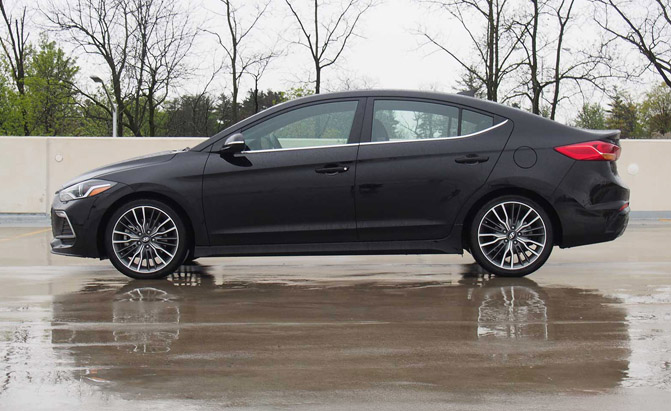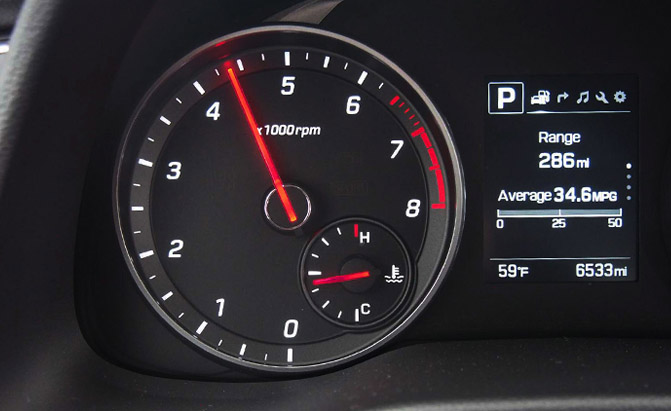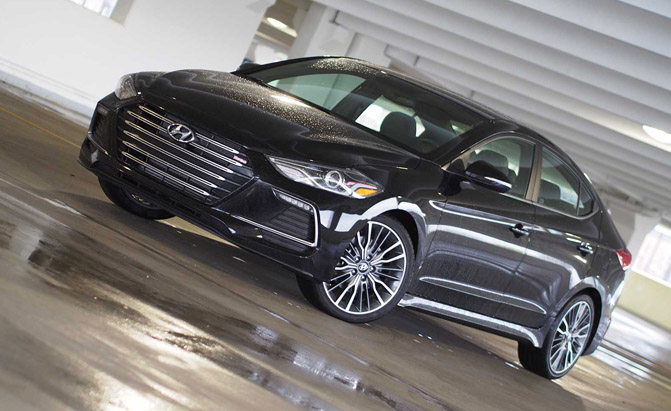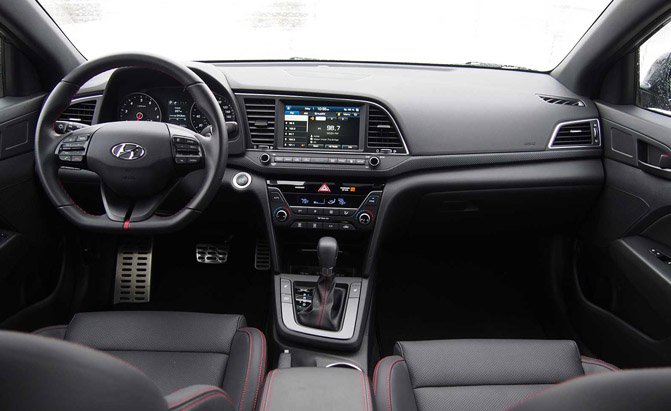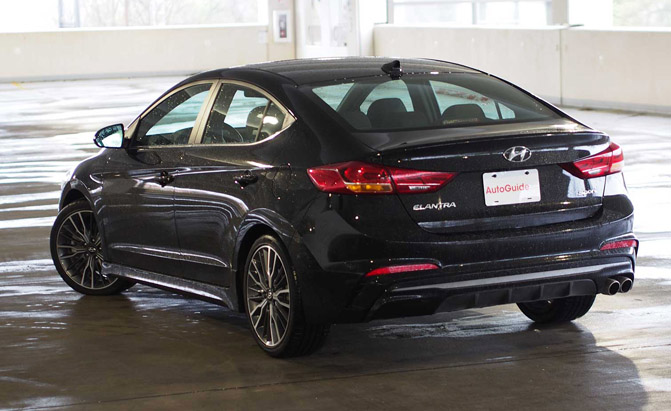Sport is an adjective that’s tossed around far too casually in the automotive world; it’s become little more than a stack of dollar bills in a strip club.
Makin’ it rain, there are sport-tuned suspension systems, sport seats, sporty flat-bottomed steering wheels, sport-themed rocker trim, sport-branded crossovers, sporty wheels. Where does it end?
Like President Trump in the wake of countless scandals in his first 100-odd days, this word has lost all credibility. Justifiably, before reviewing the 2017 Hyundai Elantra Sport I was more than a bit incredulous about this South Korean compact sedan, which is part of a larger family, including a hatchback and eco model.
Punchy Performance
Nonetheless, my attitude improved when I first explored the accelerator pedal’s lower limits. This car is quick, hustling in a way that’s unexpected for the class, which usually prioritizes efficiency and affordability over rapid acceleration, but I digress.
And why shouldn’t it surprise? Tucked behind its handsome grille is a 1.6-liter Gamma four-cylinder engine (Hyundai engines are named after Greek letters. Opa!). With a turbocharger huffing air into its quartet of intake runners this dynamo cranks out 201 horsepower and 195 lb-ft of torque. For those of you that are counting, that’s an increase of 54 ponies and 63 units of twist compared to the standard, naturally aspirated Elantra.
These figures also exceed what the top engines in major rivals including Honda’s Civic and the Mazda3 can muster.
Like a foi-gras goose’s liver, this force-fed four is creamy smooth. Extremely well isolated from the cabin, it goes about its business without fuss, though the sounds it produces are anything but melodic, which is a shame. At full song, this engine moans in a sickly tone even by four-cylinder standards, sounding more Rebecca Black than Aretha Franklin. Supposedly, the exhaust is as loud as legally allowed but it didn’t seem to make that much noise during my testing.
Spicing things up, a six-speed manual transmission is standard, catering to drivers in the know. For mass-market consumption, a seven-ratio dual-clutch automatic is on the options menu, adding $1,100 to the price tag ($1,500 Canadian).
ALSO SEE: 2017 Hyundai Elantra Sport vs 2017 Honda Civic Touring
Regrettably, our provided test car featured this self-shifting unit, which, on the bright side, can change ratios in the blink of an eye. However, its low-speed performance leaves much to be desired. This transmission shudders, balks and is sometimes slow to react. The one or two MPG engineers probably picked up by going the dual-clutch route were definitely not worth these tradeoffs, at least to me.
That being said, the Elantra Sport’s fuel-economy ratings of 26 miles per gallon city (8.9 L/100 KM) and 33 highway (7.0 L/100 KM) might be enough for you to pardon these shortcomings. Combined, this car is rated at an impressive 29 MPG (8.1 L/100 KM).
Mostly Sporty
Aside from its significantly more muscular engine, this version of the Elantra also benefits from a passel of important chassis upgrades compared to its non-Sport siblings.
For starters, it features a multilink rear suspension compared to the torsion beam found in lesser cars. Additionally, the front stabilizer bar is larger in diameter plus it gains one of these at the rear. On top of these tweaks, the steering ratio has been quickened for a nimbler feel.
Build some speed and toss this compact into a turn and it feels planted and confidence inspiring, though the ride is a bit stiff and some road noise is not afraid to make its presence felt. Body roll is minimal, though benign understeer results when cooking corners with too much gas. Larger front brake rotors that span a full foot in diameter rein this car in when things get out of hand.
On the subject of steering, it’s rather enigmatic, something that’s typical of today’s electrically boosted setups. The weighting is balanced but never does it clearly communicate with the driver. Instead, the Elantra Sport’s tiller neither amazes nor annoys.
Looking the Part
This Hyundai is a blend of compelling and confounding. Its optional automatic transmission is hard to get along with, but this is tempered by powerful acceleration. Steering feel is ho-hum but the chassis is willing to play. It’s very much tit for tat; there’s a plus for each minus.
However, one aspect of this sedan that’s not up for debate is the styling. It may well be the prettiest compact car on the market today. The ever-handsome Mazda3 is starting to go gray, Honda’s award-winning Civic is a bit too robotic, the Ford Focus is attractive enough but still not as nice, and the Toyota Corolla… wait, do they still make the Corolla? My undiagnosed narcolepsy kicked in simply by thinking about that sleepy sedan.
Inside and out, this car is simply beautiful. In Sport guise, it’s dressed up with unique fascias, front and rear, a hexagonal grille, stylish 18-inch wheels wrapped in high-performance all-season rubber and even standard HID headlamps with LED daytime running lights.
The cockpit is just as tasteful, with an elegantly simple dashboard. The shapes are logical and most of the controls fall readily to hand.
There’s a smattering of soft plastics, but this is offset by a fair amount of hard plastic, which is par for the compact course. Fortunately, nothing is flagrantly chintzy and the build quality is impeccable.
A capacious interior is another major win for the Elantra Sport. Its backseat is roomy, even for oversized adults, and the trunk is huge, measuring a full 14.4 cubic feet (407 liters). That’s a bit more than you get in either a Mazda3 or Ford Focus sedan, but a touch less than offered by four-door versions of the Honda Civic or Chevy Cruze.
Upping the luxury factor is an available Premium Package, which includes a power sunroof, blind-spot monitoring, rear cross-traffic alert and even an eight-speaker Infinity sound system.
ALSO SEE: New 2018 Hyundai Elantra GT Gains European Flair and Sport Model
An eight-inch navigation screen is included in this options group as well. Bright and clear, this system is mostly easy to figure out and snappy to use. It’s refreshingly well thought out, especially for a car this affordable. Automakers in the premium segment could learn from Hyundai’s efforts here.
The Verdict: 2017 Hyundai Elantra Sport Review
The 2017 Hyundai Elantra Sport is a fast and fun compact sedan with premium trimmings and sensible fuel economy. It’s also easy on the eyes and offers a large amount of interior space. If you must go the automatic route and can deal with a somewhat recalcitrant transmission, and if you don’t mind a sickly sounding engine, this is a car that’s hard to fault.
Base price for an Elantra Sport with a row-your-own gearbox is $22,485 ($24,999 Canadian), including $835 in delivery fees. With the automatic, $2,400 Premium Package and $125 optional carpeted floor mats our tester checked out at $26,110 ($28,999 Canadian). That’s a big stack of singles, though still entirely reasonable for this segment so it shouldn’t eat too far into your monthly lap-dance budget; Gemini and Mandy down at the Stardust Unicorn are sure to be relieved.
Discuss this story on our Hyundai Elantra Forum







